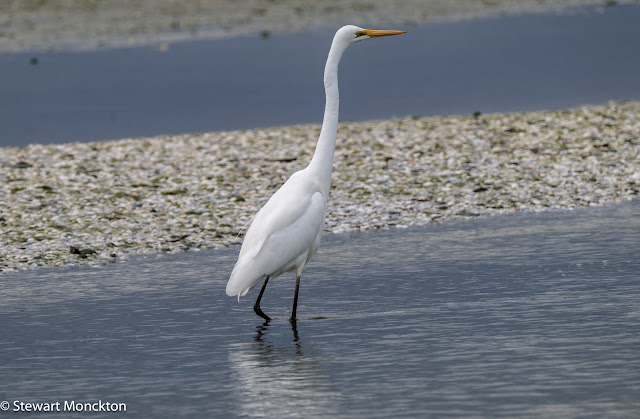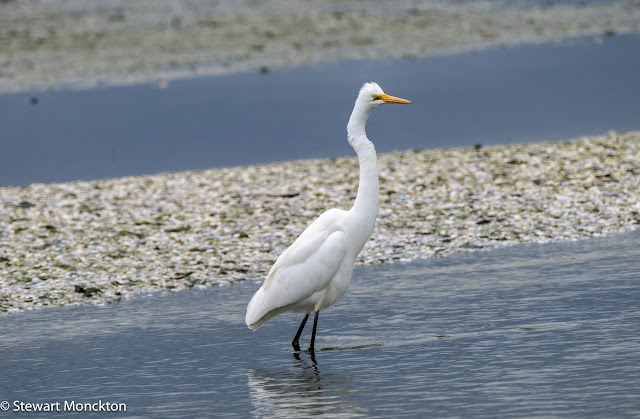Paying Ready Attention - Photo Gallery
Wednesday, 20 August 2025
Wild Bird Wednesday 682 - Brolga
Wednesday, 13 August 2025
Wild Bird Wednesday 681 - Musk Duck
The Musk Duck (Biziura lobata) is a powerfully built duck found only in Australia. The male is Australia's largest duck. Adult males are 60 to 70 cm long and have a distinctive large, leathery lobe underneath the bill; females are 47 to 55 cm long and lack the lobe beneath the bill.
This species is a member of the 'still tail' group of ducks - and in some of the pictures you can see the fan like tail either sticking up, or being folded back over the top of the bird.
In 'Wildfowl' by Madge and Burn, (which is a bit of a classic!) this species is described as 'a large and bizarre Australian duck, one of the oddest of wildfowl' and its picture is shown on a plate labeled as 'Aberrant Ducks'!
Although these images are in black and white, there was almost no colour in the original pictures. A basically black duck under a heavy grey sky does not lend itself to lots of colour.
As both of these birds have a lobe beneath the bill, I assume that they are males. So this behaviour could either be just territorial or it could be some form of display to impress the females. My library is rather lack in detail on the behaviour of this species. There was a lot of leg slapping, tail contourtions and splashing going on.
As ever, to join in with WBW click on the link below. SM
You are invited to the Inlinkz link party!
Click here to enterWednesday, 6 August 2025
Wild Bird Wednesday 680 - Little Pied Cormorant
The Little Pied Cormorant (Microcarbo melanoleucos) is a common is a common species found around the coastal and inland waters of Australia, New Guinea, New Zealand, Timor-Leste and Indonesia. Its range also extends in to the islands of the south-western Pacific and the Subantarctic. In my part of the world - South East Australia - is pretty much the default black and white cormorant.
The Little Pied Cormorant is a small cormorant measuring 56–58 cm, with a short 3 cm bill; it has a small black head crest. I actually think that 'has a kind of punk rock hair do' would actually be a useful addition to the descriptions in field guide - but maybe that's just me!
Almost inevitably, these pictures were taken at Werribee Sewage Works.
Three of these pictures show the bird in its classic wing drying / heat regulation pose.
This post may be a little shorter than normal as I am just about recovering from an epic week in the Tasmanian mountains - you can see pictures from that trip (but no bird pictures) here.
As ever, to join in with WBW, click on the link below. Cheers SM
You are invited to the Inlinkz link party!
Click here to enterMonday, 4 August 2025
Overland Track
The Overland Track is a 65km walk that travels through and past some of the highest mountains in Tasmanian. As part of a 12 person group, I walked the OLT last week over 6 days.
The weather was a bit damp to start with, but we finished with three days of wonderful clear, cold weather. In fact we were incredibly lucky with the weather given that the next land mass south of us was Antarctica!
Days ranged from 17 to 8 km, and side trips added a bit of distance and often a reasonable bit of elevation.
SM
Wednesday, 30 July 2025
Wild Bird Wednesday 679 - Great White Egret
The Great White Egret (Ardea alba) is found over most of the globe - and this individual is in Australia, at the Western Treatment Plant, aka Werribee.
Given such a wide spread distribution it is not surprising that some of the more isolated populations of this bird are considered subspecies, or even full species in their own right. Historically, this was the case with Australian birds - but as far as I can tell a consensus is forming that Australian birds are 'at best' a subspecies. I may be the only one here who finds this kind of taxonomy interesting!
In Australia this species is described as being the 'largest, lankiest longest necked egret', and its neck often has an obvious kink. In SE Australia, it's not really a difficult bird to separate from other white egrets,
As ever, to join in with WBW click on the link below. SM
You are invited to the Inlinkz link party!
Click here to enter


















































